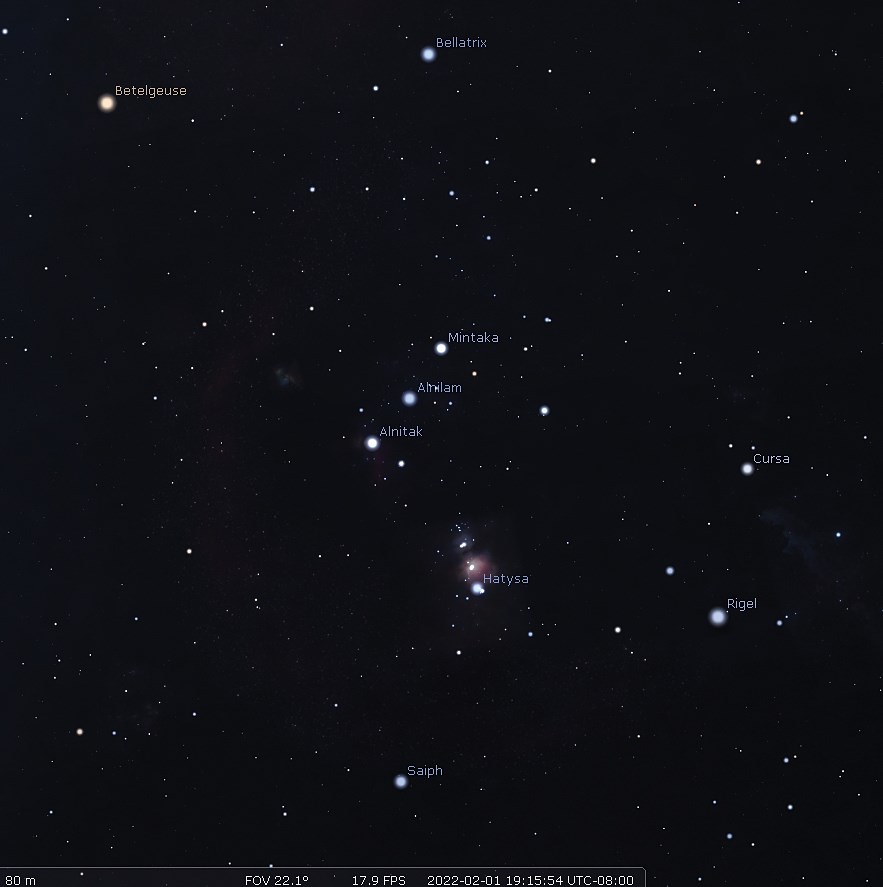February will have all of the visible planets fairly close to the sun with Venus being the only obvious one in the southeast before sunrise. Curiously, although Mars is nearly on the other side of the solar system and both it and Earth are circling the sun, at this point in our orbits, while the stars move to the right day by day, Mars moves to the left and will basically hang in the same spot above the horizon all month. The morning of Feb. 27, starting at 0545, should see the International Space
Station appear in the west, pass overhead to the north and set just north of due east about 0553. Just after 0600, a thin crescent moon will rise in the southeast with Mars about 5 degrees above it and a bright Venus about the same above Mars. Please note that all ISS predictions are iffy; NASA regularly adjusts the station’s orbit to compensate for its slight atmospheric drag.
February is just about the perfect time for observing the constellation Orion. It straddles the celestial equator and is due south at 2100 on Feb. 1, about 40 degrees above the horizon. Orion contains seven bright stars in its familiar hourglass-shaped asterism, one at each top and bottom corner and the row of three known as the Belt of Orion (in our culture’s version). When you look at Orion, you’re looking straight out of the Milky Way galaxy in the main plane of stars; the galactic center in Sagittarius is exactly behind you, due north about 40 degrees below the horizon.
At the top left is bright pinkish (I think) Betelgeuse, a red supergiant that is less than 10 million years old. It likely started out about 20 times the mass of the sun and seems to have blown off at least one solar mass via an extreme solar wind. It has long been known as a variable star but underwent a mysterious dimming for most of 2020 when its light output dropped by a factor of two to three. I’m not sure if the cause has been determined but it was notably dimmer to the naked eye. Betelgeuse has expanded from its origin as a massive blue-white star when it started to fuse helium in its core and left the main sequence perhaps a million years ago. Its diameter now is about the same as our solar system’s asteroid belt – about 500 million miles! It’s about 600 light years away and its size and distance make it possible to actually image the surface of the star, although just barely. The dynamics of its core, convection layers and outer atmosphere are a definite topic of interest to astronomers. Regardless, Betelgeuse will likely explode as a supernova within the next million years, an event that will be almost as bright as the moon and probably visible in daylight for some months.
The brightest star in Orion is at the opposite corner – lower right – and is named Rigel. It is distinctly blue-white, unlike Betelgeuse, and is estimated to be about 20+ solar masses with an age of about eight million years. Rigel is classed as a blue supergiant with a radius estimated to be 35 million miles – about the orbit of Mercury – and a luminosity roughly 100,000 times that of our sun and is about 860 light years away. It’s a little younger than Betelgeuse but will share the same fate – expand into a supergiant and then go out with a colossal explosion. Both stars are likely to end up as neutron stars or possibly black holes, depending on how much mass they shed before their cores collapse.
The rest of my intro-level guide to Orion will have to wait for another article; there is far too much to cover in 800 words or so. So, please wait with bated breath for the Belt of Orion (including another truly huge star), the Sword of Orion, which includes the Great Nebula, and other fainter things to see, as well as the distinctively bright semicircle of stars that surround Orion.
If you haven’t downloaded Stellarium yet, you should. It’s free and will, after a brief learning curve, provide you with views of the skies for any location on Earth for any time, including embedded views of all the deep-sky objects only visible through telescopes.
The club website at: sunshinecoastastronomy.wordpress.com will have information on the speaker and topic and how to register for the meeting the week prior.
The “Heavens Above” website heavens-above.com will show you a star chart for anyplace/anytime to check out all the above events, especially details on the ISS. Finally, the Sunshine Coast Astronomy Club now has its own YouTube channel, at which the club is posting its ongoing lectures and presentations from our monthly meetings.



